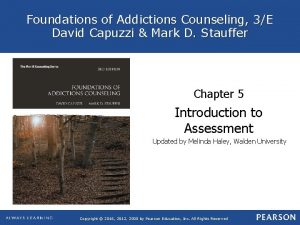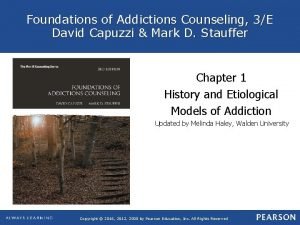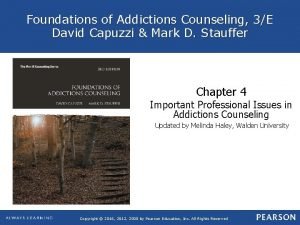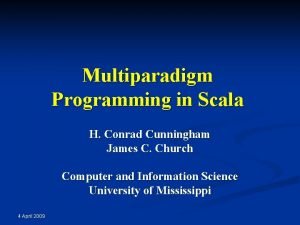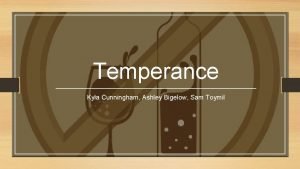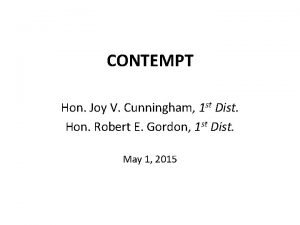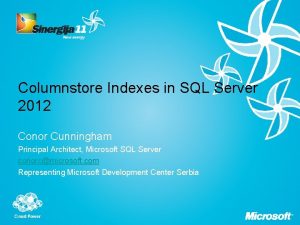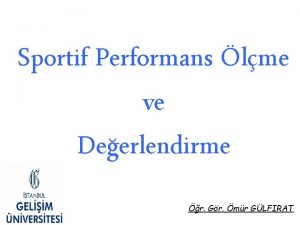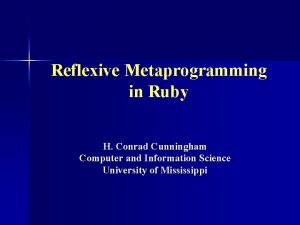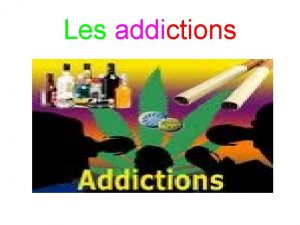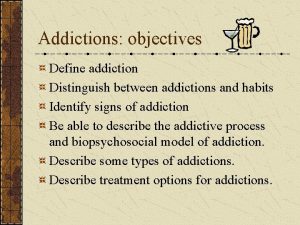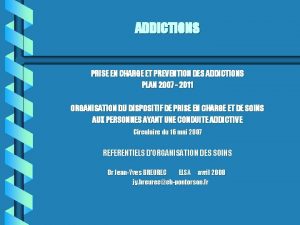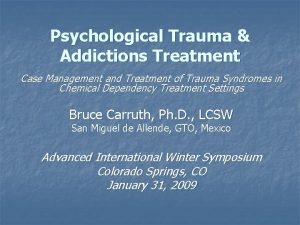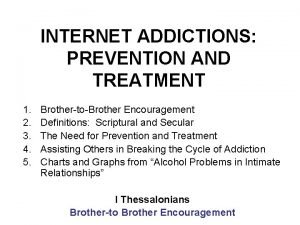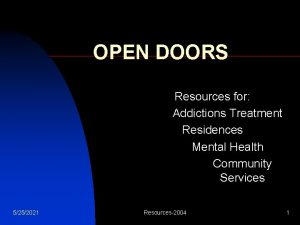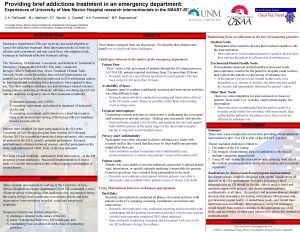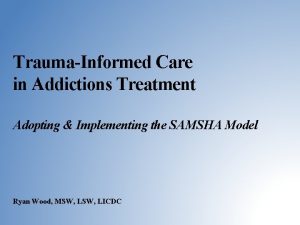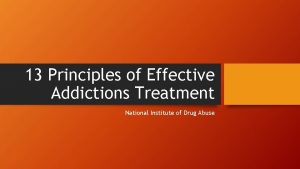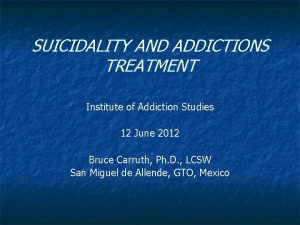Online Treatment for Addictions John Cunningham 1 What








































- Slides: 40

Online Treatment for Addictions John Cunningham 1

What I’m interested in How do people change their behaviour? What tools do clinicians use to motivate this change? Can these tools be applied in different settings to help motivate people who do not come to treatment? How do we demonstrate that these tools are effective? 2

Why is this important? Many people do not come to treatment Waiting lists Treatment dropout Many people with gambling and other addictions concerns are interested in self-help materials 3

Why the Internet? Brief self-help interventions well suited to the Internet Problem Gamblers (NODS past year probable pathological gambler) n 73% had home access to the Internet w Adult population, Ontario, Canada, 2007 4

Why the Internet? Why participants choose online help: n n n I have easy access to a computer (69%) It is important to me to be able to access MM at any time of day (38%) I like the privacy (38%) It is easier for me to write about my feelings and experiences than to speak about them in front of a group (25%; Females = 35%, Males = 13%) Online participation is easier than attending meetings due to my busy work schedule (23%) 5

Why the Internet? Online participation as a step to seeking treatment n Pathways disclosure model No evidence that people are using Internet instead of treatment 6

Today’s talk What do they look like? n Alcohol intervention as main example What evidence exists? n Research interludes Note: My conflict of interest n Dr. Cunningham has acted as a paid consultant to V-CC Systems Inc. , the owner of the Alcohol Help Center and the Check Your Gambling software. 7

What do they look like? Common elements: n n n Self-test to check levels of problems Cognitive behavioural tools Support group 8

Check Your Gambling screener www. Check. Your. Gambling. net n Screener Survey Contains: w Frequency of different gambling behaviours w CPGI w Amount of money spent on gambling w Gambling Cognitions Questionnaire w Demographics Normative comparison data from Canadian Community Health Survey 9

10

11

12

Research interlude Evaluation of the Check Your Drinking screener 13

14

Research designs Research where program is given face-to-face n Problem – external validity Studies where respondents are recruited over the Internet n n Studies with no randomly assigned control group Problem – low follow-up rates Recruiting by email, telephone n Problem – will the person access the intervention? 15

Recruitment by telephone Use RDD telephone survey to identify at-risk drinkers n Identify those who are hypothetically interested in an Internet program that provides a summary of the person’s drinking and compares it to the drinking of other Canadians w Home access to the Internet w Ask these people if they are interested in taking part in a study to help us revise and evaluate self-help materials w Send description and consent form n n Randomly assign to receive or not receive intervention Follow-up to assess differences at three-, six- and twelvemonth follow-up 16

Subject recruitment RDD screening survey of 8, 467 respondents n Excluded: w w w AUDIT-C < 4: 5, 721 Not interested in online self-help materials: 1, 936 No home internet: 100 Did not agree to view consent form: 316 Viewed consent form but did not sign and return: 209 Randomized to condition: 185 Complete 3 and 6 month follow-up data available for 91% of sample 17

AUDIT > 11: Drinks per week 30% reduction in weekly drinking 18

Issues running the study One-third of people assigned to experimental condition are not accessing the website n Study becomes one testing the impact of providing access to the intervention 19

Back to the content The Alcohol Help Center n www. Alcohol. Help. Centre. net or www. Alcohol. Help. Center. net Toolbox n Contains common cognitive behavioural and relapse prevention tools used in treatment and self-help books Moderated Support Group 20

21

22

Complexities with evaluations Content is research-based, however: n n Translating face-to-face interventions to an online format Difference of participant behaviour in online and face-to-face settings 23

Process research How do people use online interventions? Examples from online moderated support groups 24

Research interlude Online support groups as social support networks for problem drinkers 25

26

27

Content of messages The most common content (N = 647): n n n Introductions/greetings/thanks for support (30%) General messages of encouragement (17%) Questions about site/go to IM buddies (13%) Specific suggestions/what worked for me (12%) Experiencing urges/concern about future event (8%) From support specialists: w General encouragement (17%) w Specific suggestions for what might help (18%) 28

Summary AHC just starting up n n Does not appear to be self-sustaining as of yet Discussions clustered around ‘nodes’ of one or two active users Support staff playing essential role n n n Keeping discussions active by ‘seeding’ Providing support when others not online High quality content 29

Research interlude How quickly do people respond? 30

SSC Support Group 31

Methods Stop. Smoking. Center. net (SSC) version 5. 0 Lifecycle of version 5. 0: Nov 6 2004 – May 15, 2007 16, 764 registrations 15% post on the support group 32

How long does it take to get a reply? • 25% of first posts have a reply within 12 minutes • 50% of first posts have a reply within 29 minutes • 75% of first posts have a reply within 1 hour 27 min • 81. 8% of replies by members, rest by moderator • only 68/2562 did not get a reply at all. 33

What’s next? More research n Understanding why these interventions work What other tools might be helpful? 34

New tools Tools to promote engagement n n Text messages and emails Personal Profile You. Tube Videos Blogs 35

36

37

38

39

Collaborators and Funding Collaborators: Joanne Cordingley, David Hodgins, Keith Humphreys, Anja Koski-Jännes, Trevor van Mierlo, Cameron Wild Sources of Funding: Centre for Addiction and Mental Health Canadian Institutes of Health Research National Institute on Alcohol Abuse and Alcoholism Ontario Problem Gambling Research Centre V-CC Systems Inc. Contact: John_Cunningham@camh. net 40
 Foundations of addictions counseling 3rd edition
Foundations of addictions counseling 3rd edition Supracultural model of addiction
Supracultural model of addiction Capuzzi and stauffer
Capuzzi and stauffer Substance use addictions and related behaviours
Substance use addictions and related behaviours Walter cunningham personality
Walter cunningham personality Frances cunningham finch
Frances cunningham finch Cunningham tekniği
Cunningham tekniği Claude cunningham
Claude cunningham Conrad cunningham
Conrad cunningham Dr sarah cunningham
Dr sarah cunningham Cunningham curriculum definition
Cunningham curriculum definition Brianna cunningham and robert abrams
Brianna cunningham and robert abrams Chapter 2-3 to kill a mockingbird
Chapter 2-3 to kill a mockingbird Ashley bigelow
Ashley bigelow Joy cunningham
Joy cunningham Statistics sample rates conor cunningham
Statistics sample rates conor cunningham Ted cunningham marriage
Ted cunningham marriage Cunningham faulkner test
Cunningham faulkner test Conrad cunningham
Conrad cunningham Dr elizabeth cunningham
Dr elizabeth cunningham What did dill dare jem to do?
What did dill dare jem to do? Audel cunningham
Audel cunningham Cunningham
Cunningham Cecilia cunningham
Cecilia cunningham Clark d cunningham
Clark d cunningham Iso 22301 utbildning
Iso 22301 utbildning Novell typiska drag
Novell typiska drag Nationell inriktning för artificiell intelligens
Nationell inriktning för artificiell intelligens Returpilarna
Returpilarna Shingelfrisyren
Shingelfrisyren En lathund för arbete med kontinuitetshantering
En lathund för arbete med kontinuitetshantering Underlag för särskild löneskatt på pensionskostnader
Underlag för särskild löneskatt på pensionskostnader Vilotidsbok
Vilotidsbok Anatomi organ reproduksi
Anatomi organ reproduksi Förklara densitet för barn
Förklara densitet för barn Datorkunskap för nybörjare
Datorkunskap för nybörjare Boverket ka
Boverket ka Hur skriver man en tes
Hur skriver man en tes Delegerande ledarstil
Delegerande ledarstil Nyckelkompetenser för livslångt lärande
Nyckelkompetenser för livslångt lärande Påbyggnader för flakfordon
Påbyggnader för flakfordon
